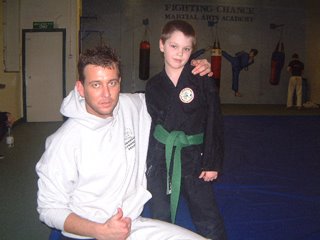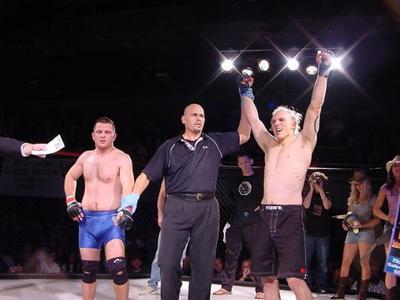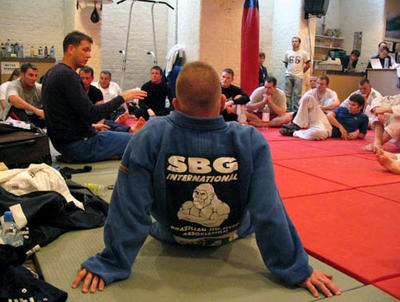Originally published November 28, 2007
![[karlchokeschicken.jpg]](http://1.bp.blogspot.com/_-qHUEL1YczU/R04UVrhGZ5I/AAAAAAAAAEw/ppGu50Am_vY/s1600/karlchokeschicken.jpg)
Being an excellent coach in BJJ requires proficiency in three different areas.
The first is, of course, your own personal performance. To receive a black belt in BJJ you should have the performance ability of a black belt. However, being able to perform or even compete well as a black belt is no guarantee you can teach others the art. In fact, some of the worst coaches I have seen also happen to be great competitors. It’s important to note that teaching and coaching skills are a separate skill set. Just like your own game, teaching others requires training, practice, and attention.
In addition to your own performance and teaching ability, there is a separate talent that I feel is equally important. It plays a valued role in both your rolling and coaching skills. This talent is the ability to evaluate the skills sets, strengths, weaknesses, openings, and talents of someone else’s game.
![[mattguard.jpg]](http://1.bp.blogspot.com/_-qHUEL1YczU/R04UprhGZ6I/AAAAAAAAAE4/kshKrB_PUmg/s1600/mattguard.jpg)
Some people can teach a great class and have a good game on the mat, but when it comes to being able to spot holes in somebody else’s game, or areas that could most use improvement, they falter a bit. I have met other coaches that could tell, after observing even a single roll, exactly what kind of game another person is using and how that game will match up as it relates to the bigger picture of BJJ.
This talent is directly linked to your overall understanding of the art itself. That big picture analysis requires among other things, the ability to determine what is a fundamental, and what is not. That is what I want to discuss in this article.
Those of you that have trained with me in person know that my entire coaching philosophy is based on the importance of solid fundamentals and drilling them in a safe, but very Alive, manner. As such, this is a topic I think about a lot, and it goes to the heart of my entire teaching theory as it relates to SBGi.
![[haueter.jpg]](http://3.bp.blogspot.com/_-qHUEL1YczU/R04U6LhGZ7I/AAAAAAAAAFA/at4C-BHf5To/s1600/haueter.jpg)
As a student of BJJ, being able to determine what is a fundamental and what is not is important. What everyone needs to know, and what may be more “style-specific”, is in my opinion one of the most important skills you can develop. As such, here is a simple guideline I often teach.
A fundamental must meet at least 3 basic points:
1- It’s something everyone who plays BJJ needs to know how to do.
2- It’s something everyone who plays BJJ will do in, essentially, the same way.
3- It’s something everyone who plays BJJ will need to do viscerally while rolling (i.e.: without conscious thought) in order to play the game well.
![[mar05thornton06.jpg]](http://2.bp.blogspot.com/_-qHUEL1YczU/R04VK7hGZ8I/AAAAAAAAAFI/7H99KkNPeP8/s1600/mar05thornton06.jpg)
As an example, not everyone who plays BJJ at a black belt level plays X guard. Rickson (to my knowledge) never played this type of half guard game. As such, I would not consider X guard a fundamental. This does not mean that some black belts will not use X guard as a core part of their own game (ie: Garcia), and it certainly doesn’t mean I won’t teach an X guard class in my own gym. But it does mean that you can be a perfectly good black belt, without having an X guard. The same can be said for pivot sweeps, DLR guards, rubber guard, and a whole encyclopedia of BJJ movements.
Contrast the above example with an elbow escape. Every black belt on planet Earth has a solid elbow escape (or should). The mechanics behind the basic motion won’t change much; the physics of the movement remain the same regardless of age, weight, etc. It’s one of those things all good players start to do as a natural reaction, without having to stop and think about it.
![[karlcoahes.jpg]](http://1.bp.blogspot.com/_-qHUEL1YczU/R04VbrhGZ9I/AAAAAAAAAFQ/5pi4Zbg_TCM/s1600/karlcoahes.jpg)
The ironic part is that, as a coach, the more you veer away from core fundamentals, the more I believe you stifle much of the organic growth process, the journey, that all BJJ athletes have to take.
Likewise, the more you stick to just fundamentals, the more room for creativity, play, and unique games you give to your athletes on the mat. A gym that focuses on core fundamentals will never (or rarely) have two purple belts that play the same type of game. A gym that teaches a “style“, that is deviates away from fundamentals, will wind up having a lot of students who all roll and move the same way, using the same guard passes, subs, etc.
![[scan0004.jpg]](http://1.bp.blogspot.com/_-qHUEL1YczU/R04VrrhGZ-I/AAAAAAAAAFY/IM10QdYaLr8/s1600/scan0004.jpg)
Another point to consider is how fundamentals are taught. Most (not all) fundamental movements in BJJ can be taught as broad concepts, or postures. The posture, pressure, possibility model fits perfectly here.
When you begin teaching a “style” you wind up having to teach more on a technique-by-technique basis. It’s not about universal principles, but rather the coach’s own interpretation of those principles. You’re no longer giving the athlete the freedom to explore his/her own map; you’re instead picking the routes for them. That is the weakest and slowest way to teach BJJ.
![[line.bmp]](http://2.bp.blogspot.com/_-qHUEL1YczU/R04V97hGZ_I/AAAAAAAAAFg/reqkBoEEzUU/s1600/line.bmp)
Going back to teaching methods, since most fundamental principles related to BJJ can be taught through positions/postures, most of my classes focus on position. When you’re teaching position first, staying on track in terms of fundamentals is a pretty easy task. IE: I don’t think it’s too hard to determine what the core fundamentals are for holding or escaping mount, head and arm, modified head and arm, crossides, etc. What I usually encourage student teachers to do when it comes to this topic is to answer for themselves the following questions:
The 5 Questions of BJJ:
1- Make a list of all the core fundamental positions within BJJ.
2- Determine what the top 3 to 5 things (major points, principles, concepts) are as it relates to holding that position. Ask yourself why those are the 3-5 things.
3- Determine what the top 3 to 5 things (major points, principles, concepts) are as it relates to escaping that position. And ask yourself why those are the 3-5 things. *(I seldom go above 5 because it’s usually over complex if I do so)
4- Determine the order in which those 3-5 things arise naturally during a competitive roll. Ask yourself why those 3-5 things occur in that order.
5- Create a drill to develop the top 3-5 habits in an Alive environment.
Not only is this a good exercise for teachers, I think it’s great for everyone who studies BJJ. If you take the time to answer these questions on your own, then your personal understanding of the game itself will increase a hundredfold. Barring mat time, I don’t think there is a single factor that will help you accelerate your learning curve greater then that conceptual model you have built yourself and own, in terms of personal understanding.
![[andy+punch.jpg]](http://4.bp.blogspot.com/_-qHUEL1YczU/R04WibhGaAI/AAAAAAAAAFo/8FBVQ_CuzcA/s1600/andy%2Bpunch.jpg)
That stated, it’s pretty easy to answer the above as it relates to positions once you have some serious mat time in BJJ. This process teaches you what fundamentals are, but when we venture away from positions, and more towards sweeps and submissions, the ability to determine whether something is a core fundamental, or style specific, becomes trickier. This is where I add three additional ideas:
Three teaching suggestions:
1- Curriculum-wise it’s about creating habits.
2- Teaching method-wise it’s a question of focus rather than exposure.
3- There are no rules, only warnings.
![[cage+fight.jpg]](http://4.bp.blogspot.com/_-qHUEL1YczU/R04XabhGaCI/AAAAAAAAAF4/Js71rC19SUM/s1600/cage%2Bfight.jpg)
The second one (teaching method-wise it’s a question of focus rather then exposure) means that when it comes to specific sweeps as an example, I have classified a few core basics I think everyone should know, i.e.: double ankle sweep, scissor sweep, hip bump sweep, basic butterfly hook sweep, etc. In addition, I have added the core subs, arm bar, triangle, Kimura, Americana, Uma Plata, RNC, fundamental collar chokes, etc. When I venture too far off this list, (ie: here is a rolling collar choke that presents itself off a failed Uma Plata attempt that you go for when your opponent is opening your closed guard standing) Then I usually do so more to expose the athletes to the move, as opposed to focusing an entire class, or extensive drill time, to such a move.
What you focus on is what’s critical. That does not mean that the athletes don’t get exposed to possibilities, only that the focus is on fundamentals.
![[Img10953.jpg]](http://4.bp.blogspot.com/_-qHUEL1YczU/R04YWbhGaFI/AAAAAAAAAGQ/2CNA0emF-sk/s1600/Img10953.jpg)
Likewise, I will, on occasion, break my own rules. As an example I taught an entire BJJ class last week that covered fundamental collar chokes; the high percentage ones. This class focused on the grips and chokes, and not on position. I explained as a disclaimer that I don’t usually teach that way, but wanted to throw in something different. All these students get a steady diet of positional work as they are in my gym, so no harm. The class worked out well. I wouldn’t suggest basing a curriculum on that method, but it’s fun to throw in alternative focus points from time to time.
![[414987915_edce35e642.jpg]](http://2.bp.blogspot.com/_-qHUEL1YczU/R04YJ7hGaEI/AAAAAAAAAGI/zRKhLOBp6EY/s1600/414987915_edce35e642.jpg)
Rule #3 (there are no rules, only warnings) also applies to all fundamentals. If you don’t play correct base and posture, bad things can happen (arm bars, triangles, etc.). Does that mean that a can opener will never work? No it does not. The same can be said for collar chokes when inside someone’s guard. Sometimes it works.
So here is how it flows together. Do we want our athletes (especially new people/ white belts) doing can openers and Ezekial chokes inside the closed guard?
I for one, know that is not the habit I want my beginners to develop. Again, point #1. It’s about creating habits. That does not mean that I won’t show them a can opener (especially how to counter it). That is point #2: exposure, rather than focus. When I tell them not to do a can opener I won’t say, “Because you will always get arm-barred” because that is not true. I will tell them that in Jits we have warnings, not rules, and that is point #3. If you grab the neck like this then we need to give you a huge warning as it relates to submission exposure and that is why we teach this, instead.
Now, rather then saying, “Just do this because I say so,” you are actually helping to further their understanding of why we do what we do. I think that point is critical, and often one of the things that marks a good teacher.
![[karlmatttravisrick.jpg]](http://1.bp.blogspot.com/_-qHUEL1YczU/R04YxrhGaGI/AAAAAAAAAGY/5rAtWDYelWU/s1600/karlmatttravisrick.jpg)
It is also why I follow each of the 5 questions with the follow-up question of why. The “why” question is perhaps the most important, and it’s a question that you want to encourage every student to answer for themselves. By allowing the student the freedom to think over the “why” question, you provide the space needed for them to build that conceptual model in their own head. That individual, personal understanding about the big picture of BJJ is perhaps the single biggest factor (barring mat time), that anyone can have when it comes to an accelerated learning curve.
![[matt+tatt.jpg]](http://1.bp.blogspot.com/_-qHUEL1YczU/R04W6rhGaBI/AAAAAAAAAFw/Si3dtJB0H4M/s1600/matt%2Btatt.jpg)
Those three points, habits versus options, focus versus exposure, and warnings versus rules, help balance out a solid curriculum. If you fill that curriculum with solid fundamentals, and take the time to answer the five questions of BJJ for yourself, you are bound to have success.
![[karlchokeschicken.jpg]](http://1.bp.blogspot.com/_-qHUEL1YczU/R04UVrhGZ5I/AAAAAAAAAEw/ppGu50Am_vY/s1600/karlchokeschicken.jpg)








![[mattguard.jpg]](http://1.bp.blogspot.com/_-qHUEL1YczU/R04UprhGZ6I/AAAAAAAAAE4/kshKrB_PUmg/s1600/mattguard.jpg)
![[haueter.jpg]](http://3.bp.blogspot.com/_-qHUEL1YczU/R04U6LhGZ7I/AAAAAAAAAFA/at4C-BHf5To/s1600/haueter.jpg)
![[mar05thornton06.jpg]](http://2.bp.blogspot.com/_-qHUEL1YczU/R04VK7hGZ8I/AAAAAAAAAFI/7H99KkNPeP8/s1600/mar05thornton06.jpg)
![[karlcoahes.jpg]](http://1.bp.blogspot.com/_-qHUEL1YczU/R04VbrhGZ9I/AAAAAAAAAFQ/5pi4Zbg_TCM/s1600/karlcoahes.jpg)
![[scan0004.jpg]](http://1.bp.blogspot.com/_-qHUEL1YczU/R04VrrhGZ-I/AAAAAAAAAFY/IM10QdYaLr8/s1600/scan0004.jpg)
![[line.bmp]](http://2.bp.blogspot.com/_-qHUEL1YczU/R04V97hGZ_I/AAAAAAAAAFg/reqkBoEEzUU/s1600/line.bmp)
![[andy+punch.jpg]](http://4.bp.blogspot.com/_-qHUEL1YczU/R04WibhGaAI/AAAAAAAAAFo/8FBVQ_CuzcA/s1600/andy%2Bpunch.jpg)
![[cage+fight.jpg]](http://4.bp.blogspot.com/_-qHUEL1YczU/R04XabhGaCI/AAAAAAAAAF4/Js71rC19SUM/s1600/cage%2Bfight.jpg)
![[Img10953.jpg]](http://4.bp.blogspot.com/_-qHUEL1YczU/R04YWbhGaFI/AAAAAAAAAGQ/2CNA0emF-sk/s1600/Img10953.jpg)
![[414987915_edce35e642.jpg]](http://2.bp.blogspot.com/_-qHUEL1YczU/R04YJ7hGaEI/AAAAAAAAAGI/zRKhLOBp6EY/s1600/414987915_edce35e642.jpg)
![[karlmatttravisrick.jpg]](http://1.bp.blogspot.com/_-qHUEL1YczU/R04YxrhGaGI/AAAAAAAAAGY/5rAtWDYelWU/s1600/karlmatttravisrick.jpg)
![[matt+tatt.jpg]](http://1.bp.blogspot.com/_-qHUEL1YczU/R04W6rhGaBI/AAAAAAAAAFw/Si3dtJB0H4M/s1600/matt%2Btatt.jpg)